Eating the exoskeleton of shellfish and certain seafoods provides you with a way to build your solar callus in a very counterintuitive way. The exoskeleton has massive amounts of chitin, iodine and carotenoids that help with solar callus and light assimilation. Carotenoids are organic pigments that are found in the chloroplasts and chromoplasts of plants and some other photosynthetic organisms, including some bacteria and some fungi. These bio-molecules are photo-protectors of photosynthesis in plants and I believe they perform the same function in us because they are all pro-vitamin A chemicals. Blue light destroys the relationship of Vitamin A and every human opsin known. The most critical opsin in the eye is melanopsin. Carotenoids can be produced from fats and other basic organic metabolic building blocks by all these organisms. The only animals known to produce carotenoids are aphids and spider mites, which acquired the ability and genes from fungi via lateral gene transfer. Carotenoids from the diet are stored in the fatty tissues of animals, and exclusively carnivorous animals obtain the compounds from animal fat. One of the most important carotenoids is astaxanthin which acts like an edible sunscreen because of its natural antioxidant properties. Astaxanthin is found in the exoskeleton of seafood and it is made by the micro algae they consume. It offers sea animals protection from the sun.
Because astaxanthin gets into the brain and retina it brings antioxidant and anti-inflammatory protection to the eyes, brain and central nervous system and reduces our risk for cataracts, macular degeneration, blindness, dementia and Alzheimer’s disease. Astaxanthin is soluble in lipids, so it incorporates into cell membranes where sunlight interacts with it to protect you.
Carotenoids are photo-inactivators for our eye clock (SCN). When excessive blue light is present more Vitamin A (retinol) is made initially, before it becomes extinguished in the macula. Why is that patrons?
Astaxanthin is the most effective carotenoids at “singlet oxygen quenching,” making it a an ideal way to build the retina and skin’s ability to build the solar callus. Astaxanthin is unusual because it can also penetrate the blood brain barrier and the blood retinal barrier in the eye to offer protection that few other bio-molecules can. Nature does not make things easy it just makes them worthwhile……….
Have you ever heard of carotenoid protection (CAR)? Aphids use it to protect them from EMF’s and so do we!!! We both use it to protect us from nnEMF like RF radar and microwaves…………..but it can also help build our solar callus to regenerate our tissues when we get ill from a mitochondrial disease.
Most photosensitizers are organic dyes, but we use carotenoids and parts of proteins as photosensitizers and inactivators.
Carotenoid protection takes singlet oxygen and extinguishes the excitation reaction from light. Singlet O2 + 1CAR = triplet O2 + 3CAR
The deactivation 3CAR >1CAR + liberation of heat or IR light.
Don’t forget this thing about IR light here. Below it will become important for building your solar callus.
Photosensitizers have rules……quantum optical rules they must follow.
1. Excitation
2. Decays
3. Type 1 or Type 2 reactions (which are O2 dependent)
4. Carotenoid protection
After absorption of light photons, the photosensitizer is first transferred to an excited singlet state by the quantized energy in the photon. Then 3 possible decay channels are possible. This is why quantum physics works on probabilities and not absolutes. The 3 cases are non radiative, radiative singlet state decay to the ground state, and intersystem crossing to an excited triplet state.
Anyone who avoids seafood/crustaceans to get this photo protection for ANY reason is not part of my tribe. This is why seafood is at the top of my Epi-paleo Rx in my book on Amazon. IT IS A SIMPLE QUANTUM RULE SET FORTH BY MOTHER NATURE, not by me.
THE SECOND WAY TO BUILD YOUR SOLAR CALLUS:
AM morning light has no UV light but has balanced blue and red light frequencies. This type of light is excellent for building your callus.
The picture below shows the you second way a ‘mitochondriac” can improve their solar callus. You must get IR-A light on your skin prior to any UV-A or UV-B being placed upon your skin. This is easiest in the earlier morning or the later afternoon. Please look at the picture below how red light is capable or building a “tolerance” to skin erythema. This is the basis of my hybrid tanning technique to regenerate the skin to absorb massive amounts of UV light to build a large local store of melatonin. Melatonin is the hormone that repairs mtDNA damage in humans.
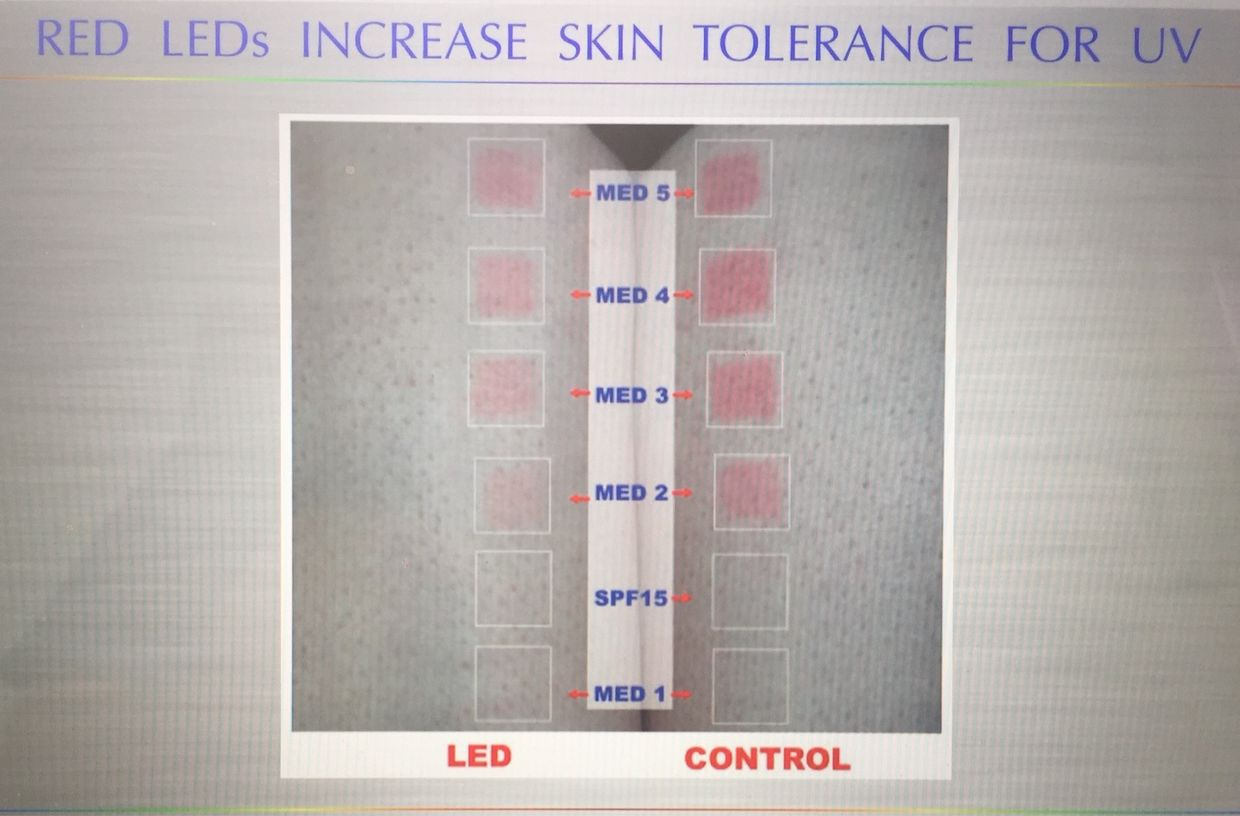
You can see from the picture above that the more IR-A/red light one gets the less erythema response comes from the skin when it is placed in full spectrum sunlight with UV radiation. IR-A light makes a protein called filiggrin in the skin. IR-A light stimulates fibroblasts to make this protein in our skin and it is loaded with histadine. Filiggrin must be in skin to develop our solar callus. In fact, loss of function knock out studies on this bio-molecule have shown that disease like ichthyosis vulgarism and atopic dermatitis, asthma, and allergies will follow. Loss of filiggrin always thins the stratum corneum in the skin. These people are way more sensitive solar damage. This points out that any reduction in the concentration of filiggrin is always tied to a reduction in urocanic acid. This is the acid that sensitizes our skin to proper UV protection. Filiggrin is also the key protein in the front line of defense of most immune conditions. I think people with autoimmune conditions and high rates of skin cancers have reduced levels of filiggrin in there skin because they lack IR-A light exposure to their skin fibroblasts to make this bio-molecule. When filiggrin is lacking the skin also cannot retain water so this makes the isomerization step from sulfated cholesterol to sulfate Vitamin D impossible and this is why all AI’s are associated with low Vitamin D 3 levels in my opinion. RF/microwave radiation is the main reason in the modern world I believe this is occurring. This is a key piece of evidence of how you can stay healthy longer once you understand how it fits into the quantum framework of how we work in nature. Any time you build melatonin anywhere in your body you improve your sleep efficiency and this also helps regenerate many other tissues. Since the skin is your biggest organ it makes sense to use it as your key to way fix your health issues from a quantum perspective. This does not just work in me………it works in everyone as the picture below shows.
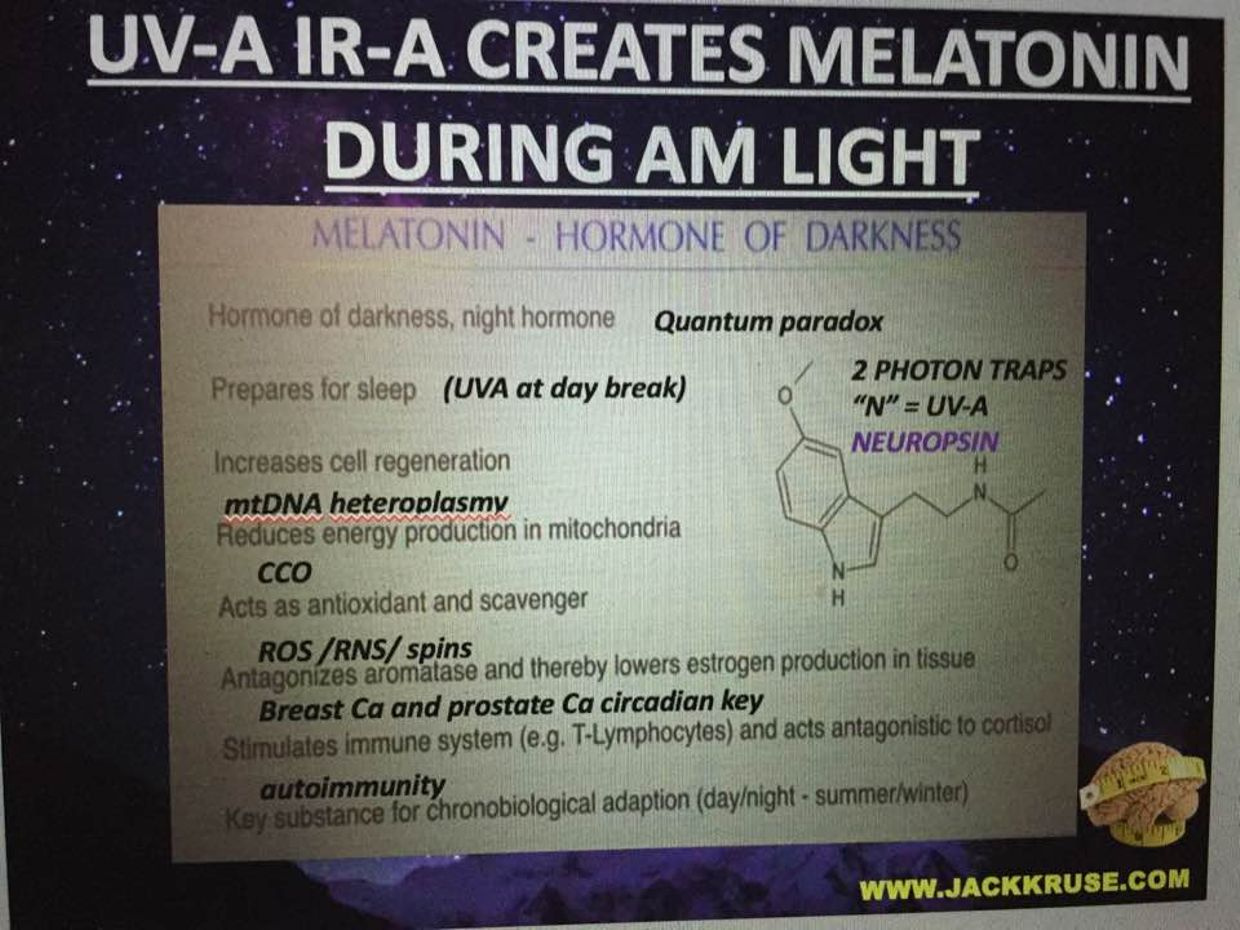
Now for the clinical win: Here is one of my members at my website, www.jackkruse.com who got the precise Rx of how to help his girlfriend resolve one of the hardest conditions in dermatology to deal with: MELASMA. Ask any dermatologist about this condition and they will roll their eyes because it flummoxes them so.
So what did I tell my member? I gave them a precise idea based upon data they shared with me on an educational consult about her haplotypes and her SNP’s along with her current location, altitude, latitude and population density. So what was her result with how she built her solar callus with respect to her melasma?
Here ya go patrons:
Hi Dr. Kruse,
Great chatting a couple weeks ago about ‘xxxxxx’ skin issues. It not only helped her but it has helped me too. We just got back from the Bahamas and I have to tell you, I followed your advice and soaked up every bit of sun from sunrise to about 10 AM to condition the skin and eye (D minder said D produced at about 9:05 AM). Then I spent the day on the boat and beach and didn’t burn like I think may have otherwise. I think this hybrid tanning thing is revolutionary. In fact, by the end of the trip, I felt pretty incredible. My sleep was restored and I woke up ready to kill the day.
Melasma:
As you know, my girlfriend received a photo-facial about seven years ago when she was 23 years old. The photo-facial caused her to have a substantial amount of melasma on her face soon thereafter. Later on, the medspa told her, “oh yeah, sorry, we didn’t know that with your type of skin you probably shouldn’t do a photo-facial.”
Fast forward we have been together for 2 years, and needless to say that I have forced her into the sun without her make-up (remember modern make up blocks UV-A light ladies) probably more than she has ever been in her life. Prior to meeting me she thought getting in the sun made the melasma worse so she avoided it all costs. This is what the dermatologist told her!!! The past year we have really stepped up our sunshine. As of this past week, her melasma is almost completely gone except for a few small spots (those spots are improved greatly).
We will continue natural ‘sun treatment’ and will report back when its gone completely. Big win and I’m grateful for all your work on your mito-hacks on the mechanism behind the solar callus! Thanks Dr. Kruse!
The building of the solar callus is one of the first things a ‘mitochondriac’ needs in their armentarium. It is all tied to an aromatic amino acid called histadine.
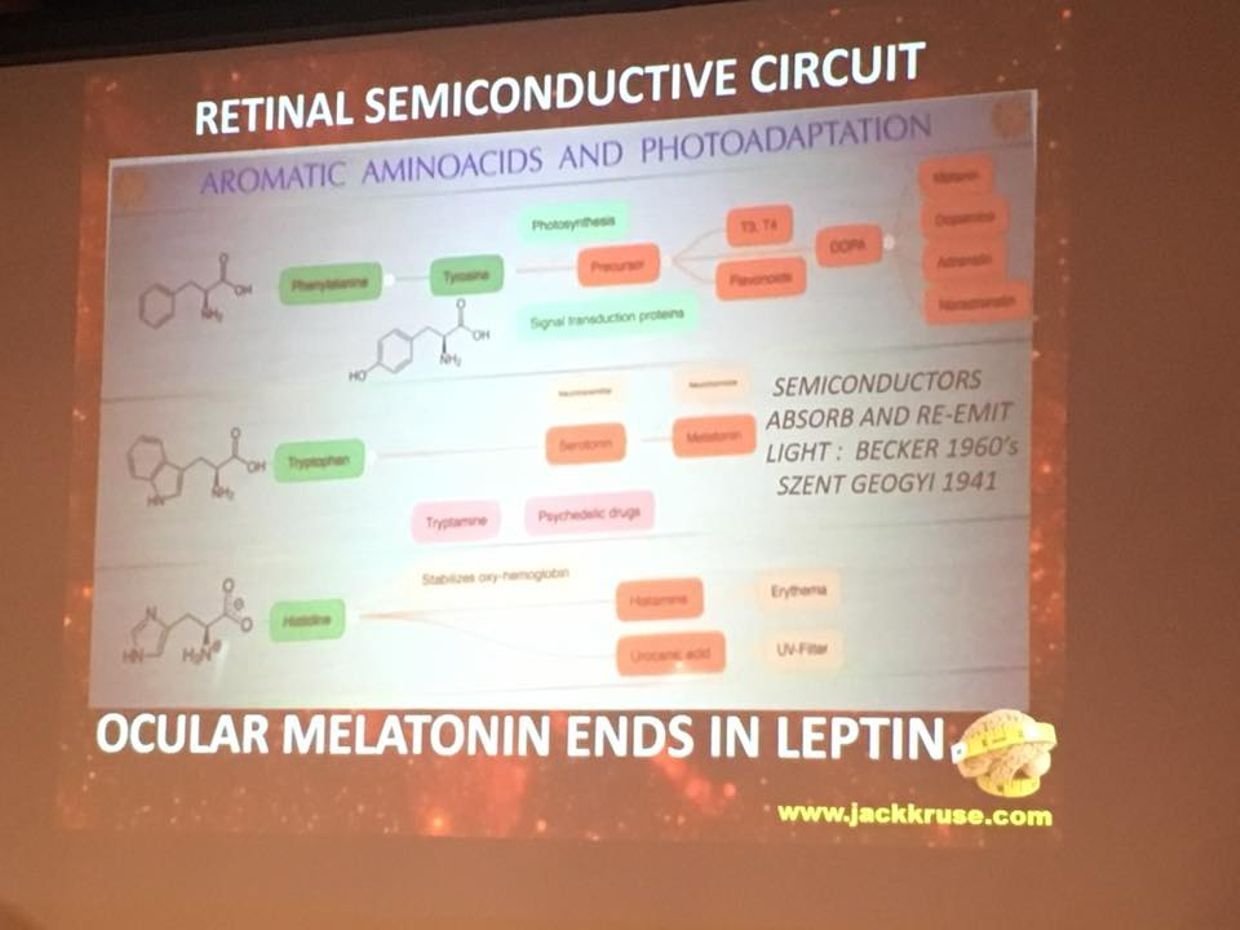
All aromatic amino acids have rings in them that absorb UV light radiation. The picture above was from my talk in Vermont 2017 and while it is not clear here, the bottom amino acid is histadine. When sunlight hits histadine, our skin makes urocanic acid that is a UV filter that protects us from erythema and skin damage. When you learn about this chemical you can use it to help regenerate many skin diseases. I’ve known about it for some time. I used it to build my own solar callus 12 years ago. It is why I can go to Mexico with my Fitzpatrick type 1 skin and do very well. In fact for the last 5 years it was the main way I was mito-hacking my job’s requirement that I take trauma call to rebuild my redox. I found it was the only way I could offset the risk of my job as I got older.
Urocanic acid is a major epidermal chromophore for all UV radiation frequencies on Earth. Urocanic acid is located in the stratum corner of the skin which is made from filiggrin. Looking back at older literature I found that Barresi and colleagues provided strong evidence for the photoprotective role of endogenous urocanic acid in human skin. Then I embarked on mito-hacks where I used the diurnal signaling of light to simulate its production on the skin. IR-A light makes up 42% of the the sun’s light and it is always present from sun rise to sunset. They key for building the solar callus is knowing when IR-A is present and when UV light is absent and pre-loading the skin with a ton of IR-A light. This is analogous to using LLLT/photobiomodulation to induce changes in the fibroblasts of the skin to make the skin ready to absorb massive amounts of UV-A light when it appears. The combination of IR-A and UV-A light is incredibly healing to local mitochondrion in the skin because these ray combinations are what increase melatonin production. Melatonin is an anti-oxidant that repairs poor mitochondrion. It stimulates repair and replacement via quantum mechanisms acting as an anti-oxidant in a very elaborate dance that lowers the basal metabolic rate of tissues where this occurs on the skin. Well melasma comes from excessive blue light with no IR-A and and UV-A light and this stimulates melanocytes on the facial skin where there is very little fat present. This usually occurs on the skin above bony prominences.
The key to understanding the action of the two forms of urocanic acid is to understand that it has two isomers linked to positive charges. This is important because light is the force carrier for the electromagnetic force. It only deals with charge particles. One isomer, trans-urocanic acid “appears to be a helpful sunscreen” and the cis-version is linked to cancer progression and ROS formation in the skin in the dermatology literature. I think this might be a false narrative. Why? What is the key to pH formation in humans? Sunlight creates and exclusion zone which excludes PROTONS!!! Maybe there is a deeper reason for how urocanic acid (UCA) really works with sunlight?
The pH of the local environment is the key to which isomer forms. This links it to the redox potential of the local tissue from how much water a mitochondrion makes from sunlight. Most of you know that water in the extracellular environment is neutral and has a tight pH range. Acid pH’s are associated with a lack of exclusion water in the skin and the blood. Acid pH’s are also associated with higher inflammation levels. Alkaline pH make a larger EZ in the skin and blood. So again, the sun makes a strong EZ alone, in any water adjacent to a hydrophilic substance. This skin is hydrophilic. Blue light is known to make ROS when it is not balanced by IR-A light like it is in AM sunlight. Remember UV-A light is never present initially at sunrise anywhere on Earth. This means our skin needs a pre-condition dose of blue and IR-A light to make just the right amount of both isomers of UCA. This yet again points out why alien blue light leads to so many diseases because blue light as a solo frequencies induces an acid pH and this fosters creation or ROS and a lowered pH. This is why melanoma, melasma, and many other skin condition are tied to artificial light exposure. I covered this in a blog on my site called “When September Ends”. It might be a good one for you to read because it was a webinar initially. When my members heard it they voted enmass for me to make it a public post because they thought it was so valuable to the public. It gives you an idea of the value I try to create for members and my patrons here.
This suggests that proton electricity is critical with respect to sunlight. Why do i say this? pH is a function of the proton concentration in a tissue and protons are a charge subatomic particle that mitochondrion use in electron chain transport. So a low pH is associated with increased UCA which reduces T^T levels in the skin. The subsequent reduction in tumor initiation and T^T-mediated photoimmunosuppression does not appear to be sufficient to counter the simultaneous increase in the level of cis-UCA, which is known to enhance photocarcinogenesis (Beissert et al., 2001). The reason this has confused researchers, in my opinion, is that none of the realize this process is entirely quantized by light frequencies present in natural sunlight. Their studies have not been completed this way. They were done in a lab under blue light so they have no idea that they way they have chosen to study this effect alters the outcome. It is pretty clear that the contributions of cis-UCA-induced intracellular ROS formation occurs (Sreevidya et al., 2010). It has been recently reported ability of cis-UCA can induce the apoptosis of tumor cells in the skin through intracellular acidification (Laihia et al., 2010). This finding told me that solar exposure and non alien light exposure have to be carefully teased out when reading papers on photo-induced damage. This should be taken into account when attempting to unravel the very confusing overall contribution of UCA to the photocarcinogenic process. Without a quantum perspective I think dermatologists and the research they rely on will continue to create false narratives about the sun.
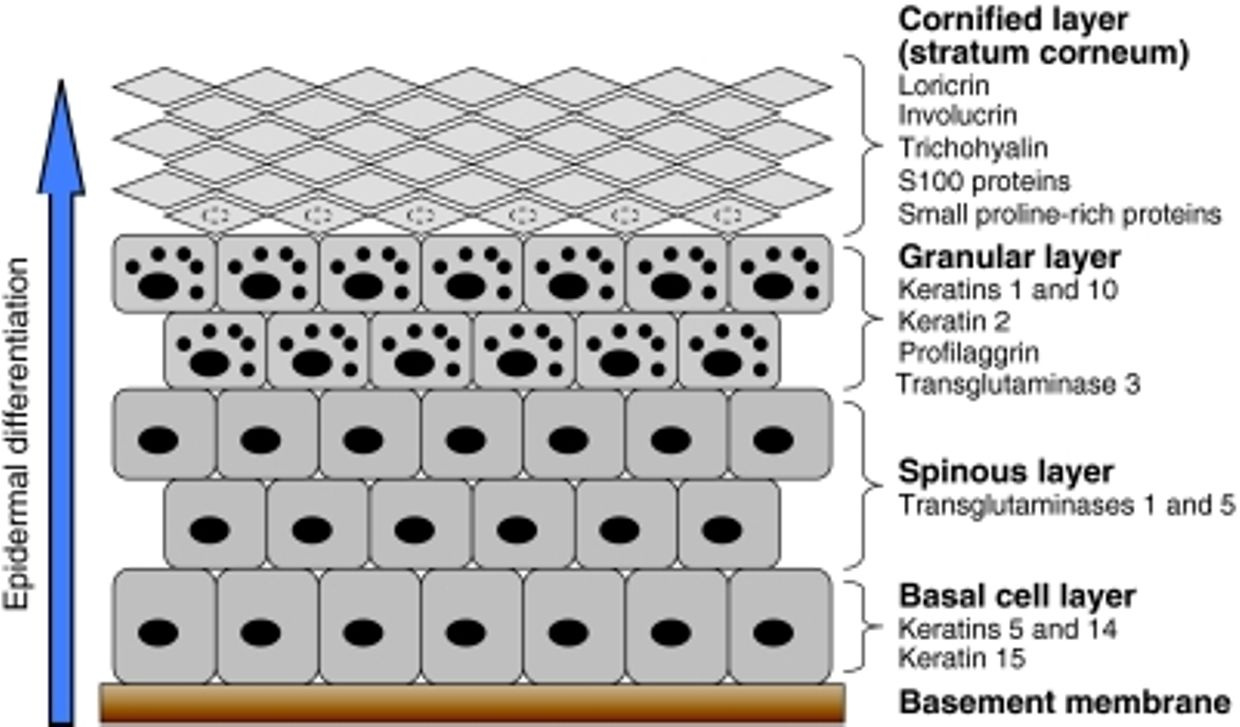
Figure story: Here is a visual story of the putative “beneficial” and “detrimental” effects of urocanic acid (UCA). (a) trans-UCA is formed in the stratum corneum from histidine (HIST) released from filaggrin; (b) exogenous trans-UCA absorbs UVR and protects against thymine dimer formation in keratinocytes; (c) cis-UCA is formed by photoisomerization of trans-UCA; (d) acting through membrane receptors, cis-UCA induces intracellular reactive oxygen species (ROS) and hence oxidative DNA damage (8-oxo-dG); (e) cis-UCA initiates translation of genes associated with apoptosis and immunosuppression through direct signaling and intracellular ROS formation; and (f) cis-UCA provides proapoptotic intracellular acidification in tumor cells. SPF, sun protection factor, T⁁T, thymine dimers.
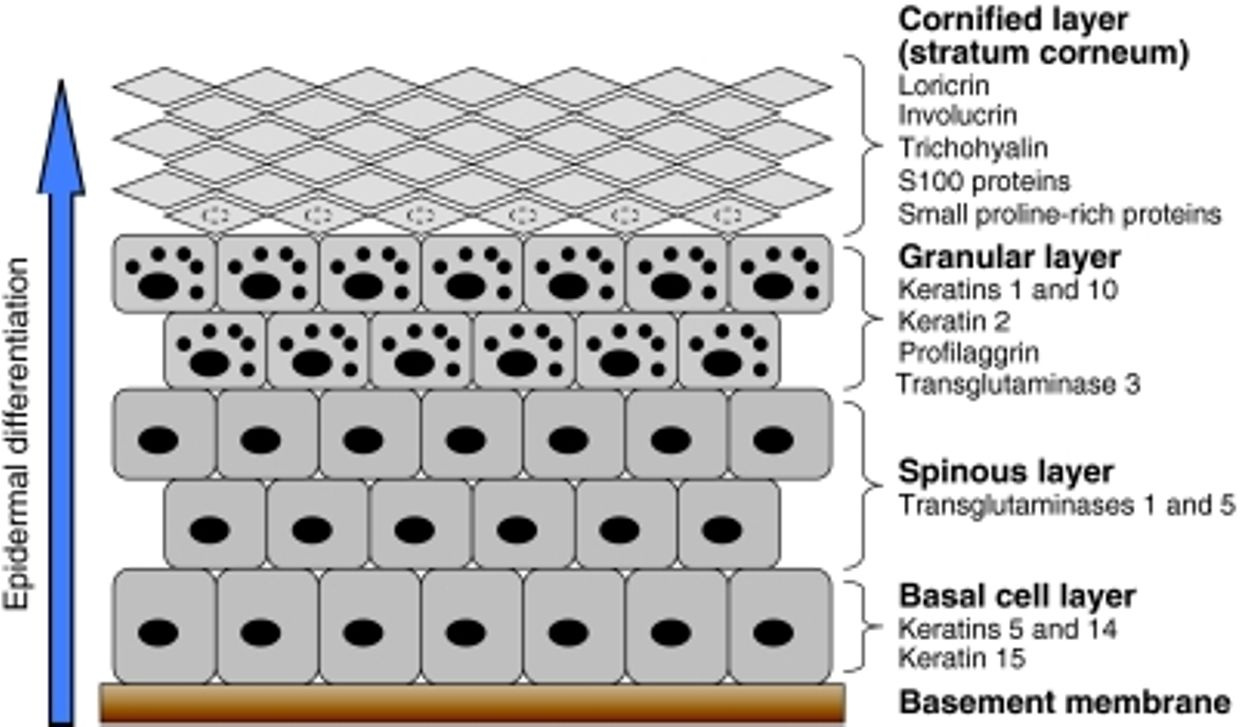
The term `filaggrin’ comes from filament-aggregating protein. It was first coined in 1981 to describe a class of structural proteins that had been isolated from the stratum corneum (Steinert et al., 1981). Filaggrin specifically interacts with intermediate filaments, particularly keratins (important in the AUGER effect) , but not with other components of the cytoskeleton of the skin like actin and microtubules. Filaggrin is synthesized as a giant precursor protein called profilaggrin from fibroblasts under the power of IR-A light. This protein is both heavily phosphorylated and insoluble. This is key for two main reasons: 1. it allows the skin to retain water and phosphorus in the skin is an important source of charge separation for animal photosynthesis to make hydrogen in the skin to make energy for the skin. People forget that Japanese researchers have show that phosphorus is a key element in splitting water into hydrogen and oxygen while liberating electrons in the process under natural solar conditions. Profilaggrin is the main constituent of the electron-dense keratohyalin granules that are found within the granular layer of the epidermis (Figure above). This should make sense now why the protein loaded with histadine and phosphorus. It liberates electrons for the keratohyalin and it liberates histadine to make urocanic acid for UV protection due to the aromatic rings in this amino acid. In this way it is molecular quantized sun screen that can retain water, make delocalized excited electrons called excitons, and block erythema formation all while stimulating the immune system to keep us well. The profilaggrin itself has no keratin-binding activity but, during the later stages of epidermal terminal differentiation under IR-A light, profilaggrin is dephosphorylated and proteolysed into multiple filaggrin monomers in a multistep process. The free filaggrin then is able to bind to keratin intermediate filaments, causing their aggregation into macrofibrils in which the intermediate filaments are aligned in tightly packed parallel arrays. This is why pretreatment with IR-A is analogous to how the body spreads its sunscreen evenly over the skin to lower sunburn risk and allow more UV light protection and assimilation to improve the skin function and make melatonin locally in deeper layers. This involves something called the Yarkovsky effect. This was covered deeply in my recent July 2017 webinar for members. This process contributes to cellular compaction in the skin and optimizes skin thickness in any solar environment. It also permits extensive crosslinking of keratin intermediate filaments by transglutaminases to form a highly insoluble keratin matrix to protect us from exterior water in the sea. This matrix acts as a protein scaffold for the attachment of cornified-envelope proteins and lipids that together form the stratum corneum. This is a critical step in the transmutation of many lipids in the skin like cholesterol and Vitamin D production. Now……..you know how to build your solar callus.
CITES:
2.Olivarius F. de Fine, H.C. Wulf, P. Therkildsen, et al.Urocanic acid isomers: relation to body site, pigmentation, stratum corneum thickness and photosensitivity Arch Dermatol Res, 289 (1997), pp. 501-505

